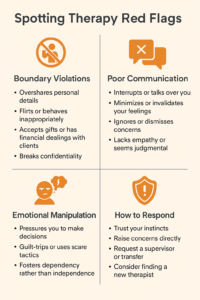Therapy is there to help us grow and heal, but sometimes, even after giving it a real shot, progress doesn’t seem to happen. Many people get stuck wondering if they’re doing something wrong or if the therapy is not clicking. It’s pretty standard to second-guess your own experience, especially when therapy is supposed to be this life-changing thing. Spotting when therapy isn’t working can be super important for your mental health adventure. I will walk you through the signs therapy might be missing the mark, and what to look out for, so you can make the most intelligent choices for yourself.
Understanding What “Therapy Failing” Actually Means
First, therapy not working doesn’t always mean it’s a total disaster. Sometimes, it just means the approach, therapist, or timing isn’t a fit right now. Therapy is personal—it’s about getting something you need- coping skills, emotional support, or a safe space to talk. If you’ve been patient and open but things feel stuck, that’s when it’s worth looking closer.
Mental health is complicated, and sometimes it takes a few tries to find what works for you. I’ve worked with people who thought therapy wasn’t helping, only to stumble upon a new approach that turned everything around. However, some warning signs signal more than just a slow process. Spotting these can save you time, money, and a lot of frustration.
Spotting Red Flags That Therapy Isn’t Working
A handful of red flags can suggest therapy isn’t giving you what you need. It’s not about expecting instant results or dramatic breakthroughs at every session; growth in treatment is usually pretty gradual. Here are several things to watch for if you’re feeling uncertain:
- Feeling Unheard or Dismissed: If you walk away from sessions feeling ignored or your concerns don’t matter, that can wear you down. Listening is a huge part of a therapist’s job.
- Lack of Progress: After a reasonable stretch—a handful of months—you notice no change in mood, outlook, or coping. Plateauing for a session or two is common, but no movement is different.
- Repeating the Same Topics Without Growth: Reviewing old ground without a fresh perspective can feel like spinning wheels. Therapy should help you see things from new angles or develop new strategies, not just repeat stories.
- Unhelpful or Judgmental Attitude: A good therapist creates a nonjudgmental, safe space. If you feel criticized or shamed, opening up is really hard.
- Missing Boundaries or Ethical Issues: If a therapist is crossing lines, like oversharing their own problems, texting at odd hours, or blurring boundaries in sessions, that’s a serious red flag.
- Pressuring or Dismissing Your Preferences: Therapy should be collaborative. If your therapist pushes their own agenda and doesn’t respect your comfort zone, that’s not okay.
What Can Cause Therapy to Fall Flat?
Therapy might not work for someone for many reasons, and usually it’s not just one thing at play. Here’s a breakdown of common reasons therapy can come up short:
- Wrong Fit Between Therapist and Client: The “relationship” with your therapist, the therapeutic alliance, is essential. If you don’t mesh or feel safe, it’s tough to go deep.
- Not the Right Therapeutic Approach: There are many therapy styles—CBT, psychodynamic, EMDR, and more. If the type isn’t right for your needs (for example, using talk therapy for trauma when body-based approaches might help more), progress just stalls.
- Unrealistic Expectations: Sometimes people expect therapy to be a magical, quick fix. Realistically, it can take months to notice significant changes, especially with deep-rooted issues.
- Lack of Consistency or Attendance: Skipping sessions or being half-in makes it hard to build real momentum. Therapy is a team effort; showing up really makes a difference.
- Personal Readiness: Sometimes, a person isn’t ready to change. That’s okay—it happens to everyone, especially if you’re feeling burned out, overbooked, or not in the right mindset.
Common Challenges and How to Tackle Them
Not every problem with therapy is a dealbreaker. Some stuff can be addressed directly; sometimes, a simple adjustment goes a long way. Here are a few issues that come up a lot and practical ways you can handle them:
Stuck in Routine
Sessions start to feel like you’re having the same conversation on repeat, and your therapist never steers things toward solutions. If that sounds familiar, tell your therapist you’d like to focus more on goals, skills, or actionable steps. Many therapists appreciate direct feedback; they’re there to help you progress.
Vague or Wishy-Washy Feedback
Sound therapy is more than just a friendly chat. You should learn new things about yourself and gain tools to handle life. If feedback stays surface-level, ask for specific suggestions or work together to create a concrete action plan.
Lack of Cultural Sensitivity
If your therapist doesn’t seem to “get” your background, culture, faith, or lived experience, therapy can feel alienating. Bringing this up can help, or you can look for someone who shares or respects your background more closely. There are online directories to help you track down therapists with particular specialties or lived experience.
Scheduling and Accessibility
Therapy loses momentum when sessions are frequently rescheduled, or it’s hard to reach your therapist when needed. Talk honestly about scheduling barriers or look around for practitioners with more availability, especially if you’re open to telehealth or remote sessions.
Essential Things to Think About Before Giving Up
It’s tempting to walk away when therapy gets tricky or awkward, but it’s worth taking a step back before making big moves. Here are some pointers that can make the decision easier:
- Reflect on Goals: Jot down what you hope to change and ask yourself if you’ve talked about these directly in sessions. Sometimes goal setting gets lost in small talk.
- Ask for a Check-In: Therapists are trained to have “progress reviews.” It’s okay to schedule a session to discuss how the process is going and whether it needs an update.
- Explore Different Modalities: Switching up the type or format of therapy can make all the difference. Group therapy, creative arts, or trauma-informed methods might feel like a better fit.
- Consider a Break: Sometimes, a pause is needed—not a full-on goodbye but some time to regroup, especially if you’re feeling saturated or burnt out.
RealWorld Examples of Therapy Red Flags
Hearing how red flags have shown up for others can make them easier to spot. Here are a few real-life examples I’ve heard about (with names and details changed for privacy):
- Someone noticed their therapist dozing off during sessions. This is an extreme case, but it is not unheard of as a breach of professionalism.
- Another person left sessions feeling worse due to heavy criticism and advice that felt more like judgment than help.
- I’ve heard therapists use sessions to vent about their lives, diverting the focus from their clients’ needs.
- Missing appointments over and over or frequently being late is another issue that affects trust and reliability.
When these things crop up, it’s a good idea to consider moving on or getting a second opinion.
Taking Action: What to Do If Therapy Isn’t Working
You have options if you realize you face some of these red flags. Here’s what I usually suggest:
- Bring It Up: Talking about what’s not working can be awkward, but many therapists welcome honest feedback. They might be able to adjust their approach or refer you to someone else.
- Try a Different Therapist: Sometimes, a different personality or therapeutic style will feel like the missing puzzle piece. Many people “shop around” for therapists; it’s perfectly normal.
- Switch Modalities: If you’ve stuck with one type of therapy, it might be time to try something new—mindfulness-based treatment, trauma-informed care, or even animal-assisted therapy might give you that spark you’ve been missing.
- Look at Your Own Involvement: It’s worth checking in with yourself: Have you been open in sessions? Are you following through on homework or trying out new tools?
Frequently Asked Questions: Therapy Troubleshooting
A lot of people feel alone when therapy isn’t working out, but you’re definitely not the only one with questions. Here are some everyday things people ask when therapy feels stalled:
Question: How long should I stick with a therapist if progress seems slow?
Answer: Usually, after about 8 to 12 sessions, you should see some minor shifts. If there’s no change or you feel uncomfortable, it’s worth discussing with your therapist or exploring other options.
Question: Is it normal to feel worse after therapy sessions?
Answer: Sometimes, jumping into hard stuff can stir up emotions and temporarily leave you feeling raw. If you always leave feeling worse, that can be a sign to reassess the process or talk to your therapist.
Question: Can I change therapists without feeling guilty?
Answer: Totally! Therapy is for you. Finding a therapist who helps you thrive is more important than worrying about hurting someone’s feelings; they will understand.
Moving Toward Better Care
Therapy works best when you feel heard, respected, and like you’re moving forward, even in small ways. Picking up on red flags can point you toward better options, whether that means tweaking your current process, trying a new type of therapy, or finding a new therapist altogether. Your mental health adventure is personal, and getting what you need matters—even if it means shaking things up until you land the right fit for you.
Remember, it’s totally normal to question and adjust your approach. You’re never “failing” just because one method or therapist doesn’t work. Sometimes, the most brilliant move is to try something different, ask for feedback, or take a short break before jumping back in. Your mental wellness is worth the effort; you deserve care that works for you.
Video: Therapy Red Flags You Should Never Ignore

